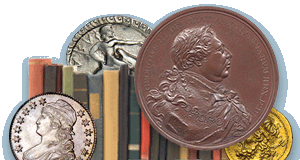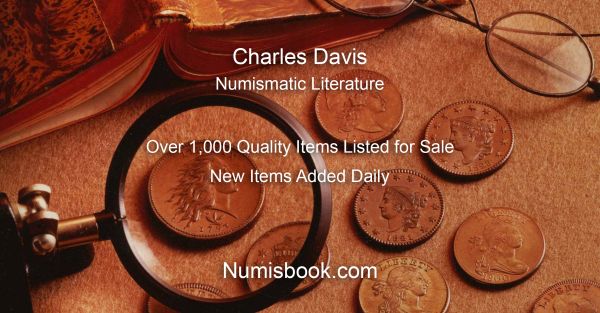
PREV ARTICLE
NEXT ARTICLE
FULL ISSUE
PREV FULL ISSUE
NOTES FROM E-SYLUM READERS: MAY 11, 2025
More on 1733 Rosa Americana Twopence Copies "I saw the article on the 1733 Rosa Americana twopence copies. With regard to the original, it is noted that five are known but I can only trace four: British Museum, Garrett, Boyd-Ford and Norweb-Ford. The Smithsonian, which is often mentioned as having one, does not. It has several copies." Thank you! -Editor
To read the earlier E-Sylum article, see:
More on the 1838-O Half Dollar "I owned two at the same time in 1975; not that easy to sell." Nancy Oliver and Richard Kelly write: "We liked the interesting story in the latest E-Sylum on the 1838-O half dollar, but couldn't help providing a bit more. We would like to add a little tidbit to said story of the striking of said coin. "In our January 2015 "Numismatic Chronicles" column in the ANA's monthly, The Numismatist, we discussed this issue at length, and had a discovery.
"Of course, we have no proof of this, but several newspapers printed this story of her possession. "Anyway, truthful or not, it made for an interesting possibility. "If readers are interested, we go into a full story of this issue, and the genealogy of the couple in our column of that date above. We also have a theory on where the piece might have ended up." Thanks, everyone! -Editor
To read the earlier E-Sylum article, see:
Connecting the Arthur Sargent Dots
I researched this Sargent the previous week and found no reference to his being a coin collector or consigning to the Chapman sale. I believe that is the same problem Mark Borckardt had. The name fits but there is no proof. I would like to know what proof, if any, was found." A name match is a great clue, but not in itself proof. It's a big world and name matches are a lot more common than one would suspect. S.H. Chapman listed the consignor as "Arthur Sargent, Esq." with no middle name. Researchers look at multiple attributes to confirm a match - date and place of birth for the subject and their family members, occupation, places lived, etc. In this case Pete is looking for confirmation that the subject ("suspect"?) was indeed a collector. This is often confirmed by the membership in coin clubs, articles published, diaries, mentions by other collectors, etc. Does anyone have more information? -Editor
To read the earlier E-Sylum article, see:
On the Norco Vodka Encased Half Dime "I have no facts about the "Norco Vodka Encased Half Dime" but here are my thoughts/impressions: "It might date to the US troops in eastern Russia at the end of World War I, at Vladivostok and along the railroad. Only the value of 25 kopecks is in Russian, with all other words in English. "FOR GRIPE SAKE" might be a soldier's lament of "For gripe's sake." Maybe an attempt to familiarize the locals with the value of coins carried by US soldiers. "Using a pre-war 60-cent value for one Russian ruble, 25 kopecks would be worth 15 cents. The silver US 5-cent coin, plus maybe some value from the Chinese copper coin, might be worth 25 kopecks due to Russian inflation during their civil war." Eric Schena writes: "That is a really interesting piece. It appears to be pre-1917 because of the older form of the E character in the fourth position (looks like a lowercase b with a line through it). Very weird that it is a half dime set inside another coin as the encasement. GRIPE SAKE I think is not a product or similar, but an expression, like an older form of "for cripe's sake". "As for Russo-Chinese trade, it would not be out of place to find some sort of multinational ad token on the eastern portion of Russia and China. Harbin and Vladivostok were close-ish and there was a lot of trade. In the 1920s and 1930s the USSR fought several battles with the Chinese and Japanese over control of railroads and trade routes. I have seen some multilingual paper money in Chinese, Russian, and English, so not too surprised by that nature of the piece. I do think that the supposition that it's a turn of the 20th century ad piece is probably close to the truth. "The other thing is that it could be from Norco, California in Riverside Co. It's definitely not unheard of for Chinese coins of all sorts to make their way to California at the turn of the 20th century, so maybe that has some sort of connection." Interesting ideas - thanks, everyone. -Editor
To read the earlier E-Sylum article, see:
Coin Analysis "Last month I went to my local library to see if they had a copy of Chinese Cash Coins by David Hartill, doubting that they would. They didn't, but the librarian told me about a program in California where the libraries will buy books that they don't have available and have them sent directly to an individual who brings them to the library when they are done with them. Within a few days I had the book. I still have the book and my problem is that I think it is so good that I don't want to turn it in, but I eventually will and buy my own copy. Others may want to look into similar programs at their local libraries. "Being the kind of guy who buys the coin before the book, I analyze coins scientifically more than I find in published data. For example, I weighed each of about 100 wu zhu coins to find the weight distribution. Wu (5) zhu is supposed to be the weight of 500 grains of millet (4 grams). In the photo, the top row is 5.0x and 5.3x grams. The second row is 4.0x to 4.5x grams. The third row 3.0x to 3.9x grams. The 4th row is 2.4x and 2.7x to 2.9x grams. The bottom one is 1.84g. There is a lot of variability in the dies of each coin and no 2 are identical. Sort of to be expected for coins that were made for hundreds of years. These days, potentially a lot could be unauthorized or recent copies. "This group is all probably authorized and a representative sample because they were obtained at various times and places during the 20th century for a few cents each and not recently when a lot more fakes are being made. About half are 5 zhu (4 grams) +/- 10%. Close to half are 4 zhu (3.2 grams) +/- 10%. A few are outside these ranges. This would seem to indicate that over time these coins became debased like almost all other coins that circulated for a long time. The outliers are probably unintentional mistakes as opposed to efforts to deceive. One coin of this group is magnetic to a refrigerator magnet, but not as magnetic as an iron coin would be. It is likely a copper coin with iron impurities in the 2-3% range. The rest of the coins are non magnetic. "Other examples of my analyses of statistically large samples of coins are that 8% of 1945-S Mercury dimes are the micro S variety. 92% are either the medium S or large S varieties. In the 1941 Mercury dimes, the S mint mark size was changed and there are small and large mint marks. Only 2% are the large S variety and 98% are the small S variety. This analysis was done decades ago when 10,000 dime bags still contained large numbers of Mercury dimes. The bags came from various sources, so I consider this data representative." Lots of numismatic fun! -Editor
"The Miller 1008 NY token minted in 1860, in my finding, has an African American fishing. I believe this token has never been described with this being forefront. I believe this has a powerful message for the time. There are so many details overlooked in various tokens / coins hobbyists have yet to discover. This being one until now." I think you're right - interesting find. -Editor
Wayne Homren, Editor The Numismatic Bibliomania Society is a non-profit organization promoting numismatic literature. See our web site at coinbooks.org. To submit items for publication in The E-Sylum, write to the Editor at this address: whomren@gmail.com To subscribe go to: Subscribe All Rights Reserved. NBS Home Page Contact the NBS webmaster 
|








